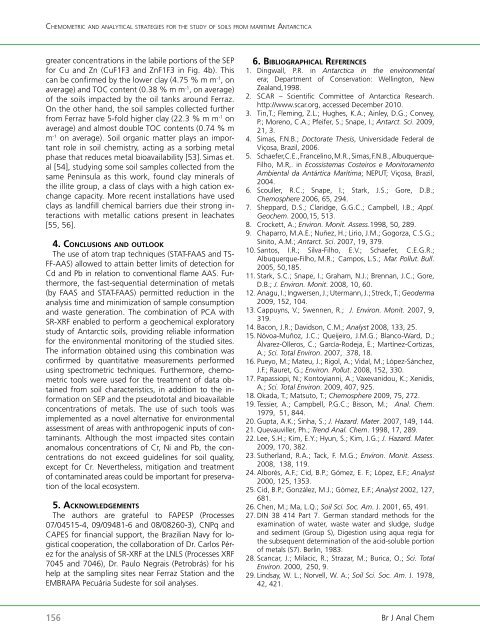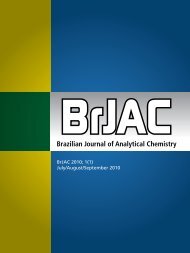Brazilian Journal of Analytical Chemistry - BRJAC - Brazilian Journal ...
Brazilian Journal of Analytical Chemistry - BRJAC - Brazilian Journal ...
Brazilian Journal of Analytical Chemistry - BRJAC - Brazilian Journal ...
Create successful ePaper yourself
Turn your PDF publications into a flip-book with our unique Google optimized e-Paper software.
ChemometriC a n d a n a l y t iC a l strategies f o r t h e s t u d y o f s o i l s f r o m m a r i t i m e an t a rC t iC a<br />
greater concentrations in the labile portions <strong>of</strong> the SEP<br />
for Cu and Zn (CuF1F3 and ZnF1F3 in Fig. 4b). This<br />
can be confirmed by the lower clay (4.75 % m m -1 , on<br />
average) and TOC content (0.38 % m m -1 , on average)<br />
<strong>of</strong> the soils impacted by the oil tanks around Ferraz.<br />
On the other hand, the soil samples collected further<br />
from Ferraz have 5-fold higher clay (22.3 % m m -1 on<br />
average) and almost double TOC contents (0.74 % m<br />
m -1 on average). Soil organic matter plays an important<br />
role in soil chemistry, acting as a sorbing metal<br />
phase that reduces metal bioavailability [53]. Simas et.<br />
al [54], studying some soil samples collected from the<br />
same Peninsula as this work, found clay minerals <strong>of</strong><br />
the illite group, a class <strong>of</strong> clays with a high cation exchange<br />
capacity. More recent installations have used<br />
clays as landfill chemical barriers due their strong interactions<br />
with metallic cations present in leachates<br />
[55, 56].<br />
4. co n c l u s Io n s a n d o u t l o o K<br />
The use <strong>of</strong> atom trap techniques (STAT-FAAS and TS-<br />
FF-AAS) allowed to attain better limits <strong>of</strong> detection for<br />
Cd and Pb in relation to conventional flame AAS. Furthermore,<br />
the fast-sequential determination <strong>of</strong> metals<br />
(by FAAS and STAT-FAAS) permitted reduction in the<br />
analysis time and minimization <strong>of</strong> sample consumption<br />
and waste generation. The combination <strong>of</strong> PCA with<br />
SR-XRF enabled to perform a geochemical exploratory<br />
study <strong>of</strong> Antarctic soils, providing reliable information<br />
for the environmental monitoring <strong>of</strong> the studied sites.<br />
The information obtained using this combination was<br />
confirmed by quantitative measurements performed<br />
using spectrometric techniques. Furthermore, chemometric<br />
tools were used for the treatment <strong>of</strong> data obtained<br />
from soil characteristics, in addition to the information<br />
on SEP and the pseudototal and bioavailable<br />
concentrations <strong>of</strong> metals. The use <strong>of</strong> such tools was<br />
implemented as a novel alternative for environmental<br />
assessment <strong>of</strong> areas with anthropogenic inputs <strong>of</strong> contaminants.<br />
Although the most impacted sites contain<br />
anomalous concentrations <strong>of</strong> Cr, Ni and Pb, the concentrations<br />
do not exceed guidelines for soil quality,<br />
except for Cr. Nevertheless, mitigation and treatment<br />
<strong>of</strong> contaminated areas could be important for preservation<br />
<strong>of</strong> the local ecosystem.<br />
5. ac K n o w l e d g e m e n t s<br />
The authors are grateful to FAPESP (Processes<br />
07/04515-4, 09/09481-6 and 08/08260-3), CNPq and<br />
CAPES for financial support, the <strong>Brazilian</strong> Navy for logistical<br />
cooperation, the collaboration <strong>of</strong> Dr. Carlos Pérez<br />
for the analysis <strong>of</strong> SR-XRF at the LNLS (Processes XRF<br />
7045 and 7046), Dr. Paulo Negrais (Petrobrás) for his<br />
help at the sampling sites near Ferraz Station and the<br />
EMBRAPA Pecuária Sudeste for soil analyses.<br />
6. bIb l Io g r a p h Ic a l references<br />
1. Dingwall, P.R. in Antarctica in the environmental<br />
era; Department <strong>of</strong> Conservation: Wellington, New<br />
Zealand,1998.<br />
2. SCAR – Scientific Committee <strong>of</strong> Antarctica Research.<br />
http://www.scar.org, accessed December 2010.<br />
3. Tin,T.; Fleming, Z.L.; Hughes, K.A.; Ainley, D.G.; Convey,<br />
P.; Moreno, C.A.; Pfeifer, S.; Snape, I.; Antarct. Sci. 2009,<br />
21, 3.<br />
4. Simas, F.N.B.; Doctorate Thesis, Universidade Federal de<br />
Viçosa, Brazil, 2006.<br />
5. Schaefer,C.E., Francelino, M.R., Simas, F.N.B., Albuquerque-<br />
Filho, M.R,. in Ecossistemas Costeiros e Monitoramento<br />
Ambiental da Antártica Marítima; NEPUT; Viçosa, Brazil,<br />
2004.<br />
6. Scouller, R.C.; Snape, I.; Stark, J.S.; Gore, D.B.;<br />
Chemosphere 2006, 65, 294.<br />
7. Sheppard, D.S.; Claridge, G.G.C.; Campbell, I.B.; Appl.<br />
Geochem. 2000,15, 513.<br />
8. Crockett, A.; Environ. Monit. Assess.1998, 50, 289.<br />
9. Chaparro, M.A.E.; Nuñez, H.; Lirio, J.M.; Gogorza, C.S.G.;<br />
Sinito, A.M.; Antarct. Sci. 2007, 19, 379.<br />
10. Santos, I.R.; Silva-Filho, E.V.; Schaefer, C.E.G.R.;<br />
Albuquerque-Filho, M.R.; Campos, L.S.; Mar. Pollut. Bull.<br />
2005, 50,185.<br />
11. Stark, S.C.; Snape, I.; Graham, N.J.; Brennan, J.C.; Gore,<br />
D.B.; J. Environ. Monit. 2008, 10, 60.<br />
12. Anagu, I.; Ingwersen, J.; Utermann, J.; Streck, T.; Geoderma<br />
2009, 152, 104.<br />
13. Cappuyns, V.; Swennen, R.; J. Environ. Monit. 2007, 9,<br />
319.<br />
14. Bacon, J.R.; Davidson, C.M.; Analyst 2008, 133, 25.<br />
15. Nóvoa-Muñoz, J.C.; Queijeiro, J.M.G.; Blanco-Ward, D.;<br />
Álvarez-Olleros, C.; García-Rodeja, E.; Martínez-Cortizas,<br />
A.; Sci. Total Environ. 2007, 378, 18.<br />
16. Pueyo, M.; Mateu, J.; Rigol, A.; Vidal, M.; López-Sánchez,<br />
J.F.; Rauret, G.; Environ. Pollut. 2008, 152, 330.<br />
17. Papassiopi, N.; Kontoyianni, A.; Vaxevanidou, K.; Xenidis,<br />
A.; Sci. Total Environ. 2009, 407, 925.<br />
18. Okada, T.; Matsuto, T.; Chemosphere 2009, 75, 272.<br />
19. Tessier, A.; Campbell, P.G.C.; Bisson, M.; Anal. Chem.<br />
1979, 51, 844.<br />
20. Gupta, A.K.; Sinha, S.; J. Hazard. Mater. 2007, 149, 144.<br />
21. Quevauviller, Ph.; Trend Anal. Chem. 1998, 17, 289.<br />
22. Lee, S.H.; Kim, E.Y.; Hyun, S.; Kim, J.G.; J. Hazard. Mater.<br />
2009, 170, 382.<br />
23. Sutherland, R.A.; Tack, F. M.G.; Environ. Monit. Assess.<br />
2008, 138, 119.<br />
24. Alborés, A.F.; Cid, B.P.; Gómez, E. F.; López, E.F.; Analyst<br />
2000, 125, 1353.<br />
25. Cid, B.P.; González, M.J.; Gómez, E.F.; Analyst 2002, 127,<br />
681.<br />
26. Chen, M.; Ma, L.Q.; Soil Sci. Soc. Am. J. 2001, 65, 491.<br />
27. DIN 38 414 Part 7. German standard methods for the<br />
examination <strong>of</strong> water, waste water and sludge, sludge<br />
and sediment (Group S), Digestion using aqua regia for<br />
the subsequent determination <strong>of</strong> the acid-soluble portion<br />
<strong>of</strong> metals (S7). Berlin, 1983.<br />
28. Scancar, J.; Milacic, R.; Strazar, M.; Burica, O.; Sci. Total<br />
Environ. 2000, 250, 9.<br />
29. Lindsay, W. L.; Norvell, W. A.; Soil Sci. Soc. Am. J. 1978,<br />
42, 421.<br />
156 Br J Anal Chem



